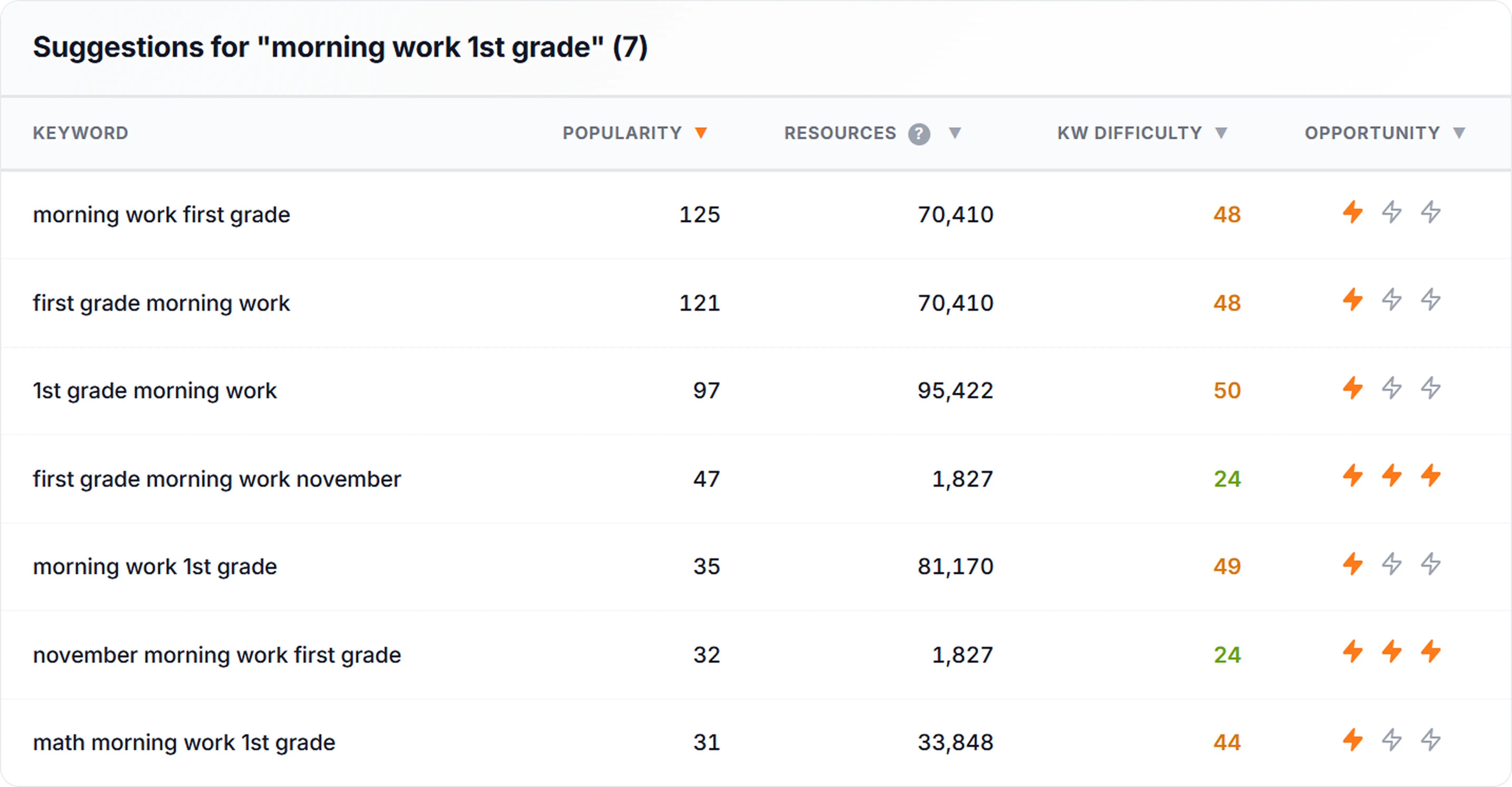In 2025, competition on Teachers Pay Teachers continues to grow. New listings appear every day, and search behavior shifts as teachers rely more heavily on TPT’s internal search engine to find exactly what they need. The result is simple: SEO is now the single most important factor in generating consistent sales on TPT.
If your product doesn’t rank for the right keywords, it doesn’t matter how good the resource is — buyers will never see it.
This guide explains how the TPT algorithm works, what affects ranking, and how you can optimize your titles, descriptions, tags, previews, and videos to increase visibility. You’ll also see how SEOLumina, a TPT-specific SEO intelligence platform, provides real data to help sellers make smarter decisions.
1. Why TPT SEO Matters More Than Ever in 2025
More than 70% of TPT purchases begin with a search inside the platform. Teachers type what they need — and buy the best-ranking resource that matches their intent.
Three major shifts in 2024–2025 made SEO essential:
-
Growing competition in core categories (math, literacy, classroom management).
-
Algorithm tightening: TPT now rewards relevance more than broad tagging.
-
Behavior-based ranking signals: listings with higher CTR and conversion rates rise faster.
Strong SEO ensures that:
-
your products appear for the right keywords,
-
your listings reach more buyers organically,
-
and your store grows even if you don’t run ads or build a large social media presence.
2. How the TPT Search Algorithm Really Works (Updated for 2025)
TPT doesn’t disclose its exact search formula, but extensive testing shows clear ranking patterns. Each part of your listing contributes differently to how high you appear in search results.
Approximate ranking influence:
🟦 Title — ~40%
The strongest ranking factor.
-
Your primary keyword must appear in the first 3–5 words.
-
Grade-level and subject keywords carry powerful intent signals.
🟦 Description — ~20%
TPT analyzes roughly the first 240 characters for keyword relevance.
This short preview determines:
-
how well your listing matches the search query,
-
whether it should rank above competitors,
-
and how it should be categorized.
Well-structured descriptions (headers, bullets, clean formatting) outperform plain text.
🟦 Tags / Keywords — ~20%
Tags help TPT understand secondary topics.
Important:
-
Long-tail tags (grade + subject + skill) perform far better than broad ones.
-
Misaligned tags can reduce relevance score.
-
Tags must reflect real buyer intent.
🟦 Cover Image (CTR Influence)
While the image itself isn’t a text-based SEO factor, it directly affects click-through rate (CTR). TPT boosts listings that earn more clicks than average for their category.
CTR is influenced by:
-
large readable text,
-
clear grade levels,
-
contrast and color clarity,
-
simple, clean layout.
🟦 Video Preview — Behavioral Ranking Signal
Video does not add keywords, but it increases engagement, which boosts ranking indirectly.
Listings with video often see:
-
longer page view time,
-
more preview clicks,
-
higher conversion rate,
-
more favorites.
These signals tell TPT the resource is high quality → higher ranking over time.
🟦 Buyer Behavior Signals — Continuous Influence
After publishing, your ranking is shaped by:
-
favorites,
-
add-to-cart actions,
-
purchases,
-
page time,
-
preview opens,
-
refund rate (negative signal).
TPT pushes listings that demonstrate strong buyer trust and engagement.
3. The 10 Most Common TPT SEO Mistakes Sellers Make
Avoiding these errors can significantly increase your visibility:
-
Using broad keywords (“math worksheet,” “reading activity”).
-
Ignoring long-tail phrases that reflect real searches.
-
Putting the primary keyword at the end of the title.
-
Overstuffing keywords in descriptions.
-
Using unclear or unstructured descriptions.
-
Copying descriptions between products.
-
Publishing without competitor research.
-
Using weak or unreadable cover images.
-
Adding irrelevant tags to “trick” the algorithm.
-
Ignoring buyer signals after publishing (poor preview, low conversion).
Fixing these basics often brings immediate ranking improvements.
4. How to Do Keyword Research for TPT in 2025
Effective keyword research focuses on two components:
1. Buyer intent
What teachers actually search for:
-
grade level
-
subject
-
topic
-
specific skill
-
format (centers, worksheets, passages)
2. Competition
If a term has 50,000+ products, it’s nearly impossible to rank without strong differentiation.
Where sellers usually find keywords:
-
top-ranking product titles
-
Pinterest search
-
Google search patterns
-
Niche Facebook groups
But manual research has limits.
This is where SEOLumina becomes a competitive advantage.
With SEOLumina, you can:
-
view real keyword product counts,
-
analyze keyword difficulty,
-
find “opportunity keywords” with high demand and low competition,
-
extract keywords from top-performing competitors,
This removes guesswork and replaces it with data.
5. Real Title Transformations: Before & After
Clear, structured titles consistently outperform short or creative ones.
Example 1
❌ “Math Worksheets for Kids”
✅ “2nd Grade Math Review Worksheets | Place Value, Addition & Subtraction”
Example 2
❌ “Writing Center Activities”
✅ “Kindergarten Writing Center | CVC Words, Sentence Building, Tracing Practice”
Example 3
❌ “Reading Passages Bundle”
✅ “1st Grade Phonics Reading Passages | Short Vowels, Fluency & Comprehension”
The structure matters:
-
Primary keyword
-
Grade/subject
-
Skill or topic
-
Format or purpose
6. High-Performing TPT Keywords in 2025
These terms consistently show strong demand:
-
morning work 1st grade
-
place value worksheets 2nd grade
-
phonics passages
-
editable behavior chart
-
kindergarten math worksheets
-
IEP goals prek
-
SEL activities for kids
-
writing prompts elementary
-
classroom jobs cards
-
3rd grade math review

Use them as inspiration, not as one-size-fits-all solutions — competition varies.
SEOLumina can calculate Difficulty and Opportunity Scores for each keyword.
7. Step-by-Step Optimization: How to Improve Any TPT Listing
Follow this workflow for consistent results:
1. Identify the primary keyword
Use data, not intuition.
2. Choose 3–5 supporting long-tail keywords
Combine grade + subject + skill.
3. Write a structured, SEO-focused title
Lead with the primary keyword.
4. Optimize the first 240 characters of the description
Explain what the resource is and who it’s for.
5. Add LSI (related) keywords naturally
Examples: printable, centers, worksheets, activities.
6. Create a strong cover image
Readable at small size, clean, high contrast.
7. Add a video preview if the product benefits from visual demonstration
Especially effective for:
-
bundles
-
editable templates
-
centers
-
seasonal resources
8. Upload a high-value preview
Show real pages, not just the cover.
9. Track performance and update regularly
Titles and descriptions should evolve with trends.
10. Use SEOLumina to monitor rankings and competition
Data removes blind spots.
8. How SEOLumina Helps You Rank Higher on TPT
SEOLumina gives sellers access to real insights that the TPT platform itself doesn’t provide.
You can:
Analyze keyword difficulty
See the real number of competing products for every keyword.
Find opportunity keywords
Discover high-demand phrases that competitors ignore.
Monitor competitors
Extract titles, keywords, and patterns from top-selling stores.
Track your visibility over time
See what changed after your updates.
This data-driven approach gives sellers a measurable SEO advantage.
9. Conclusion
Understanding ranking signals, choosing strong keywords, structuring your titles and descriptions correctly, and optimizing your visuals all combine to create listings that consistently rank and convert.
Sellers who approach SEO strategically will always outperform those who rely on luck.
With the insights from SEOLumina, you can:
-
find high-intent keywords,
-
beat competitors,
-
fix low-performing listings,
-
and grow your TPT store reliably.
Optimized listings lead to more impressions, more clicks, and more sales — and with the right data, you can make that happen intentionally, not accidentally.

